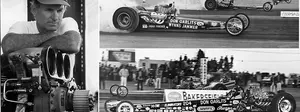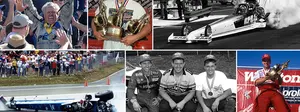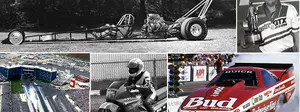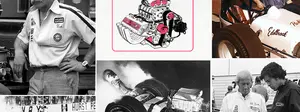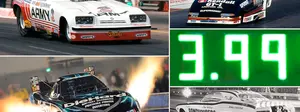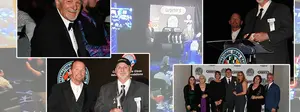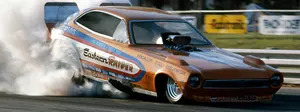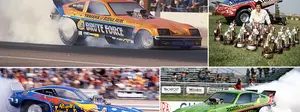

More mind-blowing mid-motor madness
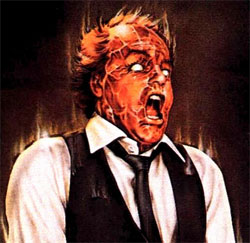 |
Maybe I’m overstating the case, but if you’re the kind of person who revels in the minute details of our sport’s history – and, hey, if you’re here, you probably are – I’m fixing to make your head explode like the deliciously gory scene from the classic 1981 horror flick Scanners (I was going to embed a video of that scene here but thought that not appropriate; the image at right is from the movie poster, but go ahead and search for the video on YouTube; I’ll wait).
Anyway, if you’re a drag racing historian, I’m going to force you to overwrite a portion of your mental hard drive with newly discovered information about the history behind the car that ultimately became John Force’s first Funny Car, the rear-engine, chain-driven Night Stalker Mustang that we’ve been discussing in the last few columns.
Ever since I first heard about the car, the story was pretty straightforward: Jack Chrisman built it but never drove it. He sold it to Roy Mehus, who crashed it on the second pass at Orange County Int’l Raceway, then repaired and rebadged it (so to speak) in a police-car theme called the Dragway Patrol (sometimes mistakenly called the Cop Patrol). Mehus then sold the car to Force. Everyone seemed to agree on those facts. So far so good, right?
Well, remember that whole debate I had with myself last Friday about whether it was Force driving the police-car-themed Dragway Patrol? Based on the helmet and face-mask design that matched those in the photos taken on the day of the ill-fated OCIR crash, I firmly believed that it was still Mehus behind the wheel; some of my historically inclined colleagues begged to differ. It’s Force, they said.
OK, are you sitting down? Good. It’s not Force. It’s not Mehus, either. Mehus NEVER drove the car. Ever.
Thanks to Adria Hight (Force’s eldest daughter) reaching out to her uncle Walker (Force’s older brother), I tracked down and spoke to Mehus Wednesday. Not being an Internet-inclined sort of fellow, he had no idea in the past interest (and errors) concerning his driving the car and certainly no knowledge of our ongoing discussion here and was quite bemused by it all.
The driver was, in fact, Bill Finacle, who had driven the Bandido fuel altered. Ta-da! Some new data for my friends at DragList.com.
(Kudos to Insider reader Mike Hedworth, who had emailed me that he believed that Mehus had a hired driver. “I remember thinking [the driver] was in law enforcement by the conversation he had with someone, and that is where I think the Dragway Patrol name came from,” he added. Half right. According to Mehus, the cop-car theme came from the idea of chasing down and catching their opponents.)
Mehus -- who knew Force because the two shared an art class at Bell Gardens High (“We were asked to create an abstract art project; John made his out of Popsicle sticks,” he recalled with a laugh. “I forget what it was, but he was pretty proud of it.”) -- confirmed that he bought the never-run Mustang from Chrisman after receiving an inheritance and put his friend Finacle behind the wheel. He never had any inclination to drive it. Finacle did indeed crash the car at OCIR and then drove it as the Dragway Patrol. Mehus remembers the car’s best performance as just 140 mph.
“It was a hard car to drive, but the idea was right,” he insisted. “The car would squat and leave hard.”
(Like Mehus, reader Allen Lasko was a firm believer in the sidewinder concept and remembers the Chrisman flopper’s debut on the pages of Hot Rod magazine. “At the time, I thought that design was sure to be the future of Funny Cars! Living in snowmobile country, I thought the next step would be to install a centrifugal clutch and drive mechanism like a snowmobile. By adjusting the clutch weights and the initial size of the sprocket, you’d have the ability to launch as hard as you’d want, and then the drive ratio would change down the track to allow a higher top-end speed. Never having read how the car actually ran up until your article, I never knew how the chain was indeed the weakest link in the system. I’m surprised you resisted using that line in your article. LOL.)”
Mehus eventually grew frustrated with footing the bill for an unsuccessful and frustrating car, got married, sold it to Force, and was part of the Force entourage into the middle 1980s as a sponsor with his Yamaha of Buena Park dealership and as a friend.
Mehus, who is retired and raises exotic birds in Arizona, fondly remembers his early involvement with the king of Funny Car and all of the wonderful things he saw and did.
“I was probably one of the first people to hold Ashley when she was a baby, and the places we went and things we did, I never would have been able to do by myself,” he said. “I learned a lot of things about racing; I would do anything to help out. We had some really good times.”

Man, you guys love your rear-engine Funny Cars! Over the course of the rear-engine Funny Car thread, a lot of interesting flotsam and jetsam has beached itself in my Inbox, adding to the sea of information on this rare breed of race car. Thanks to everyone who sent notes, photos, and clues to pursue.
 |
Virgil Hartman, whose message-board posting concerning the fate of Force’s Night Stalker I quoted last week, provided the photo at right showing the car after he had reconfigured it to standard front-engine mode.
“[It’s] the one and only photo I have of the car,” he wrote. “It is a Polaroid taken of my first pass at Irwindale with the car converted to standard Funny Car configuration. As you can see, the car sits at a different attitude, I have smaller rear tires, and my face isn't plastered up against the front windshield. I made five passes that day in the car and sold it the following weekend. I left the Night Stalker name, picture, and paint job on the car because it was in very good condition and drew a lot of attention from spectators the weekend I drove at Irwindale.
“In my youth, I loved drag racing but just couldn't bring myself to dedicate the time needed to be a serious racer. So I bought, changed, and sold race cars to support my love of the sport while I concentrated on raising a family, serving an apprenticeship after service in the Army, and starting my own business, Hartman Enterprises, which is still active today. Along the way, I had the honor of owning some cars that have a place of historical significance in the world of drag racing.
“My second dragster was a Kent Fuller creation that was used as Shirley's [Muldowney] A/D in Heart Like a Wheel. It is the one that her husband Jack trashed in their front yard. I still have the front bodywork from that car in my rafters. I bought the Brissette & Drake car that Kelly Brown drove to a world championship. I ran it as a Top Gas West car, and the person I sold it to raced brackets with it for many years. I also bought an Alcohol Funny Car from Bucky Austin, ran it for six months, and sold it to Walt Austin, who rebodied the car as a Trans Am [that] was used for [Walt's son] Pat to get his first competition license with. It later was sold to Gary Densham and then Greg Daebelliehn.”
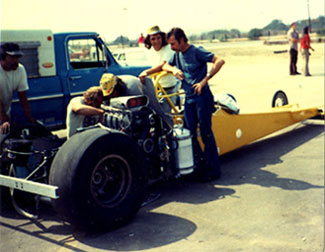 |
I heard from Michael Thompson, a friend of Ed Lenarth's and his family since the late 1960s who was with Lenarth during the Mid-Winder and the subsequent sidewinder dragster (both of which crashed).
“I've kept that car all these years,” he said. “Ed sent me home with the drivetrain just before his passing. We tested the dragster at Irwindale in ‘72 with success, then ran it at Orange County for the Grand American meet. The Genuine Suspension rear-engine dragster oiled the left lane right before our run. Steve [Reyes] was correct -- the car left hard, but just before half-track, she hit the slick spot and turned left. We could see the entire side of the car. Norm Wilt did an unbelievable driving job and swung her around only to smack the guardrail (still steel guardrail then) with the rear tire. It laid over about 20 of those 12-by-12 posts; the track was pissed. She never flipped, but it bent the rear axle, broke the chassis behind the driver, and generally bent her up. Norman was knocked out, and the car slid down the guardrail, through the lights, running in the sevens at 170-plus mph. I have the car. The frame’s behind the barn, and the front wheels, spokes, and axle that didn't get bent are in boxes.”
Can you say restoration?
 |
National Trail Raceway Sales and Marketing Manager Michael Fornataro sent this great pic of Jack Ditmars’ seldom-seen rear-engine Funny Car, a stretched Vega with an injected powerplant. I was fortunate to have contact info for Ditmars, who is better known for his line of Mini Brute Opel Kadett Funny Cars, and he was happy to share the details behind the Boss Brute, which, like the Mini Brute, was built by the late Dennis Rollain at R&B Race Cars in late 1971 and debuted in early 1972. Power came from a big-block Chevy (512 cid) with Crower injectors and was transferred to the ground though a Crowerglide slipper clutch, M&M Clutchflite trans through a Greek coupler to a Strange Engineering Dana rear end with a spool. Lifelong friend Herb Moller was his crewmember.
“We ran both cars at our Injected Funny Car Circuit events till I wadded [the Boss Brute] up at Indy just before the Nationals,” he said. “The car was faster than the Mini Brute, but not always; best times were 7.40 e.t. and 191 mph. We were just getting a handle on it when I crashed it at Indy. I believe we could have got 200 [mph] out of it if it didn’t kill me first. The very day I crashed it, when I got this car home, I cut up the body and later sold the chassis to a guy who made an Alcohol Dragster out of it. I miss the Opel and the Lil Screamer but NOT the Boss Brute.”
With a wheelbase of 109 inches, the car was a spooky handler.
“Like all the rear-engine cars, if anything went wrong that affected traction, you were in for the ride of your life. In my case, it was a valve-cover gasket that blew out and oiled one tire. Because of the driver's vantage point, you were the last to know. The car sat only 46 inches off the ground to the top of the roof panel, kinda like a Dart and really low to the ground. This was not my finest hour, but only one other existed at the time, so tracks would go out of their way to get it there and paid a bit extra, too. Twice I lost it on the smoky burnout and did a 360 both times; the crowd loved it, but I was out of control. Talking to ‘Big’ [Don Garlits] about it, he said, ‘If it's not 250 inches in wheelbase, don’t drive it.' Good advice.”
 |
Driving the car at night was especially challenging, but Ditmars had a solution for that, too.
“Look closely at the front of the car, and you can see a dowel rod right in the middle of the car coming out of the grille area,” he said. “This was a blue plastic rod that lit up at night and the only way this car could be driven; pretty scary in hindsight. All in all was a great car that ended poorly.”
By the way, Ditmars will be an honoree at next year’s Holley NHRA National Hot Rod Reunion in Bowling Green, Ky., and Moller will be with him to celebrate. Like I said, lifelong friends.
In addition to the Boss Brute and those noted in prior columns, there were other ill-fated rear-engine Funny Cars according to historian Dennis Doubleday. “In 1973, Larry Fullerton and Kevin Doheney built a rear-engine Trojan Horse 1973 Mustang. While testing the car in front of J&E Fiberglass, Fullerton crashed the car, destroying it and ending up with a broken collarbone. He was out from late February until about June of that year, then went back to his front-engine car. The same year, West Coast A/FC circuit regular Larry Derr debuted a rear-engine Vega panel and was killed in a testing accident.”
Derr’s accident was July 27, 1973, at Irwindale. According to reports, Derr’s car spun, flipped onto its top, and slid 170 feet along the guardrail before flipping over. He was taken to Santa Teresita Hospital in nearby Duarte, where he was pronounced dead. That was a pretty tragic summer at the ‘Dale because just two months earlier (April 21), 23-year-old Don Dieckman lost his life after crashing his Killer Whale Vega during the track’s 64 Funny Cars event.
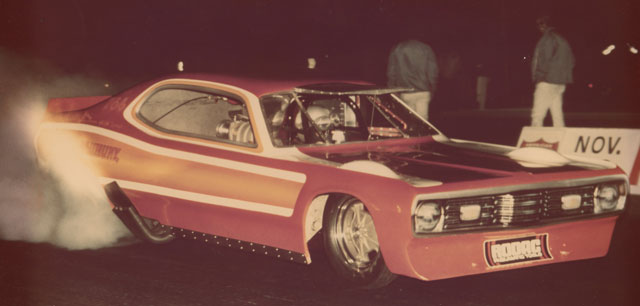 |
 |
I also heard (finally!) from Jim Adolph, the second of three drivers to try his hand in Burt Berniker’s ill-fated Hindsight entry. “I finally found this photo of the Berniker & Baumunk Hindsight, and unlike the Force confusion, this is really me driving at OCIR,” he wrote, tongue firmly planted in cheek. “Baumunk and I ran the car a few times trying to get it competitive, but it was a different animal. Like Dennis [Geisler, third driver] said, if the front end comes up at all, you lose sight. By design, it wanted a lot of clutch, but once you got the front left up, you were driving off the guardrail, and even that line of sight was poor. Baumunk was and still is very talented with metal, but neither of us were tuners. It was a real nice car with some good parts. Fun to drive; scary, too. I moved on to race with Don Green's Rat Trap/Sundance cars from there.” I really love this shot because it shows the open windshield hatch. At right is another pretty cool photo taken by our good friend Bob Snyder that shows the Hindsight under tow en route to Orange County Int’l Raceway for the 1973 Hang Ten Funny Car 500. The low-buck open trailer and Lincoln Continental “tow vehicle” harken back to an earlier day before 18-wheelers and even Chaparral trailers.
 |
 |
Regarding the rear-engine Dodge Dart that Garlits got from Jay Howell (that was subsequently crashed by Emory Cook), Doubleday also sent me the above photos. “When Garlits got the car from Branster-Howell, he initially named it Polka-Dart. However, track owners wanted [the] Garlits name/black paint everyone was familiar with, and he obliged. Both photos are from the 7-66 issue of Drag Strip magazine.”
 |
I also received this photo, purported to show Mark Williams in a rear-engine Vega panel Funny Car. Bill Holland confirmed that it was Williams in the car but that he was just shaking the car down for customer Ed Mullen of Cheyenne, Wyo. That Williams would build a rear-engine Funny Car is probably not surprising because he was a pioneer in the field of rear-engine dragsters, “having pretty much established the design and engineering standard for the breed with the Widner/Dollins car (later campaigned successfully by the Kaiser Bros.) long before Garlits' effort,” noted Holland. They've promised more information on the car, but it hadn't arrived by the time this column went live.
 |
I received the photo at right from Ritchie Boggs, son of Joe Boggs, who was the crew chief on this Don Casto-driven rear-engine Vega, shown in this photo by Art Suiter in a moment of great distress -- and one during which I’m sure that Casto was happy to have the engine behind him – at the fall 1975 IHRA Bristol event. Drag racing historian Bret Kepner also forwarded me the same photo and a ton of information about the team.
“The duo, from the Charleston, W.Va., area, had run everything from AA/Fuel Altereds to AA/Fuel Dragsters before switching to multiple REFCs,” he wrote. “Casto originally ran his own AA/FA while Boggs ran an AA/FD with the late Jim Hundley (later of Alan Starr's Starrliner FE and RE diggers). Casto and Boggs teamed up with their own FE AA/FD in '69, and after a serious fire during qualifying at the '73 Gators, they elected to move to AA/FC with a stretched Vega on a rear-engined chassis (built I believe by J. Ed Horton), which they campaigned through 1976. More recently, the car gained a bit of notoriety from a brief appearance in film coverage of the 1975 IHRA Pro-Am National at Rockingham on Chicagoan Bud Lindemann's original Car & Track syndicated television show repackaged and rebroadcast in the 1990s by Speedvision network. (Go to 03:27 at www.youtube.com/watch?v=AbOIlMMMzbA.)
“The Vega was rebodied with, of all things, a '75 Grand Am; the yellow-and-white car was alarmingly huge, and Casto looked almost like an afterthought in the Pontiac's massive windshield. I watched it clock what I believe to be a career-best 7.11 at 218 mph at the IHRA Pro-Am Nats at Rockingham in 1978; the car was just plain violent on its dry hops and launches; Casto had a propensity to run any of his machines on the absolute ragged edge at all times. I distinctly remember monstrous daylight header flames from the Grand Am, and, at night ... well, it was stunning.
“I believe it was only a few weeks after the Rockingham appearance when the Grand Am was destroyed at Blaney, S.C. Casto teamed up again with Boggs, who had been fielding a Mustang II AA/FC with fellow West Virginian Roger Hamrick. However, the trio's new yellow Trans Am was destroyed in a horrific crash (which I also witnessed) at the '78 IHRA national event at Commerce, Ga., not too soon after its debut.
“While it's a relatively obscure Funny Car, Casto's Grand Am may well be the last RE AA/FC campaigned in the United States. If nothing else, I have no doubt the Insider Nation can probably come up with something I've been unable to find for decades: a photo of the World's Only Rear-Engined Grand Am Funny Car!”
I have Boggs trying to track down more information on his dad’s car and a photo of the Grand Am, but if any of you have it, whip one my way.
Kepner also directed me to the website for Mike Puzycki's rear-engine Corvette, which may be the only contemporary back-motor car running; it competes regionally in Florida.
 |
Regarding Ed Shaver, the U.S. serviceman in England who drove the country’s most famous rear-engine Funny Car, a VX4/90, he was a friend throughout the 1990s of Racers For Christ chaplain Jim Jack, who sent background info on him.
Shaver, who also was an RFC chaplain, died May 14, 2000, at age 55. He was a United States Air Force Air Commando during the Vietnam War, during which he was awarded the Distinguished Service Cross, the Silver Star, Bronze Star with Valor, Air Force Cross, Navy Cross, Air Medal, and Airman’s Medal. He served three years in the NATO War Room during NATO exercises as air power controller. He received two Medals of Honor and the Order of Kings by the president and premier of the Republic of Vietnam.
During his racing career in England, Shaver was sponsored by Mattel, and Hot Wheels made a limited-edition diecast of his AMX; he was instrumental in the further development of drag racing in England.
Wrote Jack, “As stated in your column, Ed was a larger than life character. He told me many stories about racing and about the Vietnam War (most were not very pretty). He suffered from exposure to Agent Orange, and he was a man that lived each day as if it was his last. He was honest but at times would get in your face yet be compassionate if need be. Ed experienced three racing crashes at over 200 mph during his 12 years of professional racing. Twelve fires and the last crash broke many bones and resulted in his hairdo he carried for his last 25 years: bald. Ed knew his faith carried him through many other adventures during his last 20 years on earth.”
And that, my friends, barring any more jawdropping, head-exploding news, marks the end of the rear-engined Funny Car thread. I think.



























